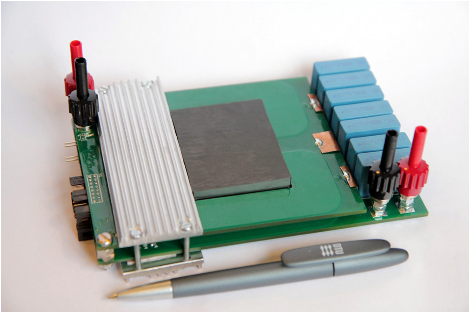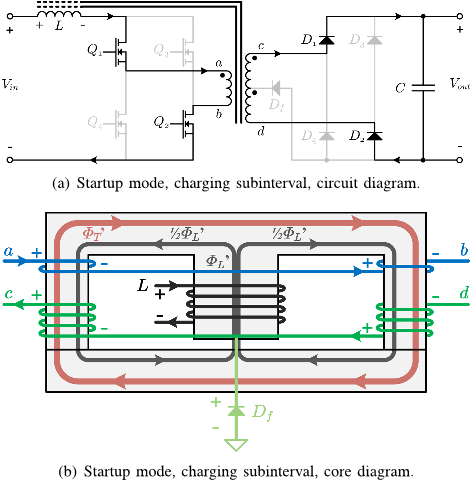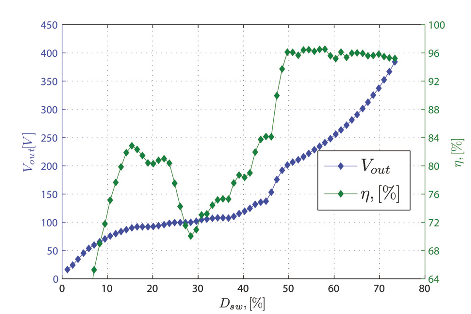subinterval of operation is shown with an electric circuit
diagram followed by the corresponding and a magnetic core
diagram. Relevant voltage polarities are marked with +/-
signs, and current directions are marked with arrows while
inactive elements are dimmed. The electric circuit diagrams
correspond to their respective core diagrams by the ports
marked a, b, c, d. The core diagrams include the flux rate,
dφ
dt
= φ
0
, induced by the inductor, as well as the flux rate
induced by the transformer. The circuit operation can be
understood by analysing voltage polarities and flux rates
together with the right hand rule, while taking into account
the switch states, current directions and diode bias.
Boost mode operation (D
sw
≥ 0.5)
In the familiar isolated boost topology, the full-bridge
switch duty cycle must be above 0.5, such that there is always
a current path available for the boost inductor. This is defined
as the normal boost mode operation. The gate signal is
phase-shifted 180
◦
between each diagonal high-side/low-side
switch pair. Since D
sw
≥ 0.5, the phase shifted gate signals
overlap such that either all switches are on, or two diagonal
switches are on.
When all switches are on, V
in
is applied to the boost inductor,
and the input current is increasing. Known as the charging
or boosting subinterval, the circuit operation during this is
shown in fig. 4. As seen in fig. 4(b), the flux rate induced by
the inductor is uncoupled from the transformer windings due
to the fact that the voltage drops induced on the transformer
windings on each side leg are of opposite polarity.
The second sub-interval, referred to as the boost mode
discharge subinterval, is shown in fig. 5. When two diagonal
switches are on and the other two are off, the inductor
current passes through the primary winding, allowing the
corresponding diagonal diode pair of the output rectifier to
become forward biased. The output voltage is reflected to the
primary winding, such that a negative voltage drop is applied
over the inductor, decreasing the current. The corresponding
core diagram in fig. 5(b) shows that the inductor flux rate
is decreasing, and is still uncoupled from the transformer.
Additionally, it is noted that the flyback diode D
f
is reverse
biased.
Start-up mode operation (D
sw
< 0.5)
When the switch duty cycle is reduced below 0.5, the
diagonal switch pairs are no longer overlapping in on-state,
meaning that either two diagonal switches are on or all
switches are off. When two switches are on, the circuit
operation is identical to the boost mode discharge subinterval,
except that the inductor current is now decreasing due to the
fact that the primary voltage is lower than the input voltage,
causing a positive voltage drop over L. Because of this,
the subinterval is referred to as the start-up mode charging
subinterval, and the corresponding circuit and core diagrams
are seen in fig. 6.
(a) Boost mode, charging subinterval, circuit diagram.
(b) Boost mode, charging subinterval, core diagram.
Fig. 4. Boost mode, charging subinterval. All switches are on, inductor
current is increasing. Core diagram shows that inductor flux rate is decoupled
from transformer.
(a) Boost mode, discharging subinterval, circuit diagram.
(b) Boost mode, discharging subinterval, core diagram.
Fig. 5. Boost mode, discharge subinterval. Two diagonal switches are on,
inductor current is decreased by transferring energy through the transformer.
It is noted that D
f
is reverse biased..
When all switches are off, there needs to be an alternative
current path such that the inductor flux remains continuous
in order to avoid MOSFET avalanche mode clamping of the
stored energy. This current path is provided by the secondary
transformer winding, which thereby acts as a flyback winding
during the flyback discharge subinterval seen in fig. 7. During
switch turn off, the inductor current is decreasing, creating a





















